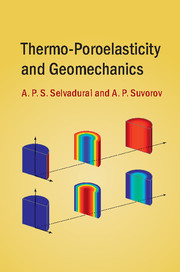Book contents
- Frontmatter
- Dedication
- Contents
- Preface
- Acknowledgements
- 1 Thermo-Poromechanics: Applications and Developments
- 2 Constitutive Relationships Governing Thermo-Poroelastic Processes
- 3 One-Dimensional Problems Involving Thermo-Poroelastic Processes
- 4 Thermo-Poroelasticity of Geomaterial With a Fluid-Filled Rigid One-Dimensional Cavity
- 5 Radially Symmetric Thermo-Poroelasticity Problems for a Solid Cylinder
- 6 Radially Symmetric Thermo-Poroelasticity Problems: Cylindrical Cavity in an Infinite Medium
- 7 Spherically Symmetric Thermo-Poroelasticity Problems for a Solid Sphere
- 8 Spherically Symmetric Thermo-Poroelasticity Problems: Spherical Cavity in an Infinite Medium
- 9 Glaciation Problems Involving Thermo-Poroelastic Processes
- Appendix
- Index
- References
8 - Spherically Symmetric Thermo-Poroelasticity Problems: Spherical Cavity in an Infinite Medium
Published online by Cambridge University Press: 10 November 2016
- Frontmatter
- Dedication
- Contents
- Preface
- Acknowledgements
- 1 Thermo-Poromechanics: Applications and Developments
- 2 Constitutive Relationships Governing Thermo-Poroelastic Processes
- 3 One-Dimensional Problems Involving Thermo-Poroelastic Processes
- 4 Thermo-Poroelasticity of Geomaterial With a Fluid-Filled Rigid One-Dimensional Cavity
- 5 Radially Symmetric Thermo-Poroelasticity Problems for a Solid Cylinder
- 6 Radially Symmetric Thermo-Poroelasticity Problems: Cylindrical Cavity in an Infinite Medium
- 7 Spherically Symmetric Thermo-Poroelasticity Problems for a Solid Sphere
- 8 Spherically Symmetric Thermo-Poroelasticity Problems: Spherical Cavity in an Infinite Medium
- 9 Glaciation Problems Involving Thermo-Poroelastic Processes
- Appendix
- Index
- References
Summary
In this chapter, we examine the coupled thermo-hydro-mechanical behavior of a fluid-saturated porous medium of infinite extent bounded internally by a fluid-filled cavity of spherical shape. The fluid within the cavity can be subjected, separately or simultaneously, to a temperature rise and a pressure pulse. We present analytical results for the spherically symmetric thermo-poroelasticity problem.
Examples of the analytical treatment of the isothermal problem of a spherical cavity are given by Rice and Cleary (1976), Rice et al. (1978) and Detournay and Cheng (1993). A solution for the response of an elastic and viscoelastic porous medium that contains a spherical cavity subjected to a constant radial stress was obtained by Spillers (1962). The nonlinear poroelastic problem of infiltration into a dry poroelastic body via a spherical cavity was analyzed by Yamagami and Kurashige (1981). The case of a rigid spherical heat source with either a pervious or impervious boundary, contained within a poroelastic medium, was examined by Booker and Savvidou (1984, 1985). Coupled heat–fluid–stress effects in a poroelastic medium with a spherical cavity were also studied by Zhou et al. (1998) and Wang and Papamichos (1999). Analysis of a fluid-filled spherical cavity embedded into a poroelastic medium is presented in the articles by de Josselin de Jong (1953), Rice et al. (1978) and Selvadurai and Suvorov (2014). The nonlinear thermo-poroelastic problem for a hollow sphere subjected to a sudden rise in temperature and pressure on its inner wall was studied by Kodashima and Kurashige (1996). Rehbinder (1995) considered similar problems with cylindrical and spherical symmetries; the stationary solutions for the nonlinear thermo-poroelastic problem were obtained using a perturbation technique.
The goal of this chapter is to present analytical results for the development of (i) fluid pressure within a spherical cavity located in a fluid-saturated poroelastic medium and (ii) the skeletal stresses at the boundary of the cavity, when the cavity is subjected, separately, to either pressurization or a temperature rise. Computational results for the spherical cavity problem were obtained using the general-purpose multiphysics computational code COMSOL.
Information
- Type
- Chapter
- Information
- Thermo-Poroelasticity and Geomechanics , pp. 178 - 197Publisher: Cambridge University PressPrint publication year: 2016
